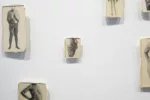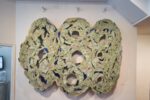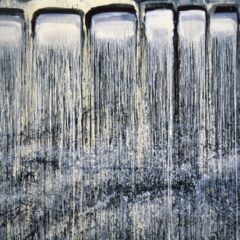Looking decidedly awake and aware, The Print Center’s 81st annual printmaking competition exhibit perked me up on an otherwise less-than day on the art circuit. The Philadelphia Museum of Art’s associate curator of prints and drawings, Shelley R. Langdale, culled 44 works by 42 artist from more than 1,600 works of mainly U.S. artists.
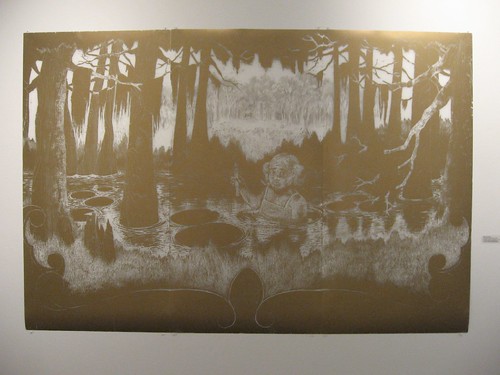
Serena Perrone, The Origin of Self-Sacrifice, woodcut, silverpoint, goldpoint on mylar, 48 x 72″
The mysterious narratives were what most captured my interest (I confess that print methodology interests me only in so far as it affects what the final product looks like). The first floor offers a huge print on mylar by Serena Perrone that combines a sense of story, theater and magic while flatness fights with layered space. The glow of the print’s gold finish is beautiful, as is the drawing technique. Perrone’s a recent RISD graduate and hails from Philadelphia.
Perrone practically knocked everyone else out of the room–temporarily. Someone recently asked me how smaller pieces can stand up to the blockbuster sized works nearby, but really, as soon as I focused on the smaller pieces, I was as engrossed by many of them, some local artists, some not, some known quantities, some not.

Katie Baldwin, Learning Spanish: Agua, 2006; Learning Spanish: Peligroso, 2006; woodblock and cut paper, 10 x 8″ each
Other Philadelphia work of note came from Katie Baldwin, who by the way also has work until July 22 at Sam Quinn Gallery, a new space in West Philadelphia, at the corner of 45th and Spruce. Baldwin’s work at the Print Center is two bold poster-like woodblock prints with cut paper, Learning Spanish. Each is an illustration of a word in Spanish–peligroso and agua. I loved the silhouetted figures toting not iPods but their bottles of agua–standard urban guerrilla gear all around the world. The world is represented by a curved horizon line beneath a greenish gold sky. I don’t think the water can quite counteract that implied mustard gas. The interface where the feet of one figure rest on top of the letters is a nice surprise.
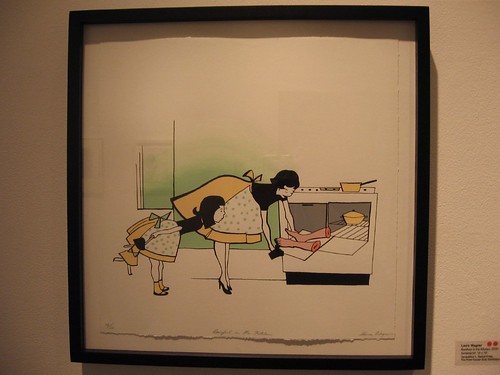
Laura Wagner, Barefoot in the Kitchen, Screenprint 15 x 15″
Philadelphia artist Laura Wagner’s tongue-in-cheek images of a ’50s mom and daughter about to roast a pair of legs, chopped-off below the knees, made me laugh out loud. Apparently, not all the Print Center loyalists agreed with me. Executive Director Liz Spungeon mentioned that Barefoot in the Kitchen, which is the show’s signature image, inspired some hate mail inspired by the bad behavior of the standard-issue good girls who dress like Julianne Moore in Far From Heaven.

Neil Burke, Arrival, 2006, screenprint, 12 x 15 3/4″
Surreal was big in this exhibit. Among local artists, surreal standouts included Neil Burke’s jaunty/spooky screenprint of sky tubes hovering over hills and balls; Kip Deeds’ stacked pair of heads filled with hands (based on a tiny plastic hand he found); and Harry Hasheian’s high-contrast night vision of Jane Doe’s House–a noir take on conventional, symmetrical taste.
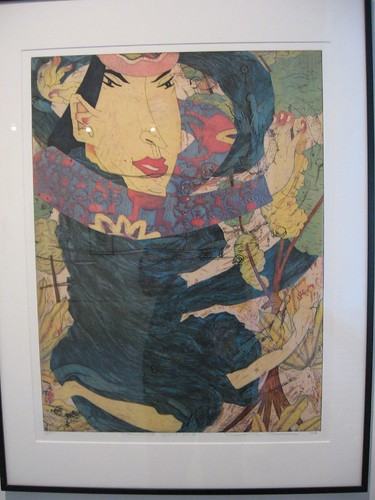
Yuji Hiratsuka, Seductive Summons, 2006, Intaglio w/ chine colle 24 x 18″
Other than that, there was so much to like in this exhibit, that I am unable to focus in on any one trend. I liked the dark cartoons of Brett Colley and of Brett Anderson (hmm, two guys named Brett!). I liked how Yuji Hiratsuka’s Seductive Summons combines dramatic ukiyo-e imagery with comicbook action. And I liked the ebullient cartoon car worship and repair in Bruce McCombs’ Gulliver’s Lincoln (a comment perhaps on Hummer madness).
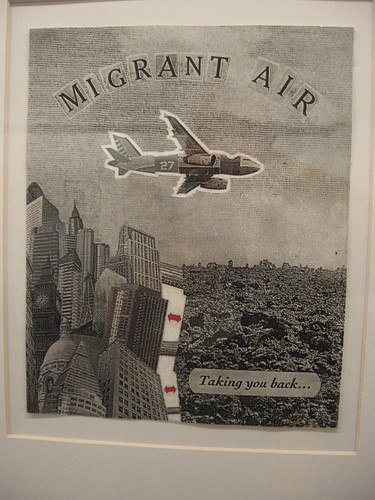
Justin Diggle, Migrant Air, 2005, photopolymer intaglio 10 x 8″
Art Hazelwood’s Battle of Foulujah, an etching and engraving, grabs imagery from map cartouches, old texts and medieval landscapes. Justin Diggle also goes political with Migrant Air, a collage look that grabs from headlines and advertising in a photopolymer intaglio.
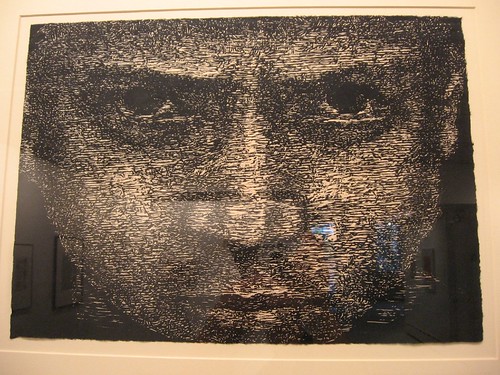
Ann Johnston-Schuster, Collateral Damaged, 2005, woodcut 12″ x 17″
Children in this show seemed under threat. Ann Johnston-Schuster’s Collateral Damage woodcut (it was a woodcut of a child’s close-cropped head that reminded me of Susan Moore’s paintings), Jane Grossenbacher’s inky photogravure Nine, of a boy spread eagled in the road–is he exuberant or injured?–and Leslie A. Golomb’s 601 paperplate lithograph of a child with tatoos, all bespoke a society that has forgotten how to protect its children.
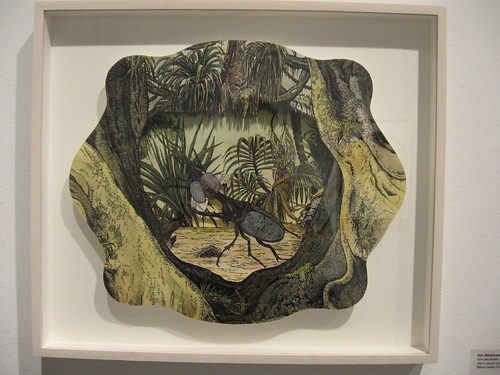
I need to thank Kim Baranowsky for breaking out of two dimensions. Her Hercules Beetle Diorama is a hand colored Xerox transfer onto two layers, one raised and framing the other. I figure if you’re going to do nature, you have to do it in some new way. So this was my favorite nature print.
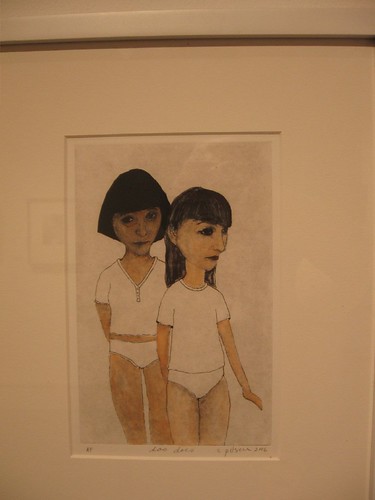
Dos Does, by Christin Pitsch, 2006, intaglio 8 x 5 1/4″
But amazingly, this was a show with not much sexuality in it. All I can think of is Christina Pitsch’s Dos Does, of two not-so young faces atop little girl bodies in little-girl white underwear. (arguably, Burke’s Arrival and Kyla Rafert Luedtke’s Jamie, a bare-midriffed young woman with a gun, could both count as sexual, but in both cases, the sexuality is not the first topic at hand). In violent times, sexuality goes to the back burner.
The exhibit will remain up until July 28.


